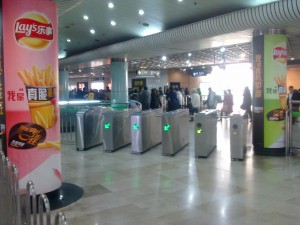Shanghai Street View: Subway Scofflaws

This week’s Street View takes us underground to Shanghai’s vast subway system, where metro police are in the midst of a crackdown on people who ride the trains without paying. I’m fully supportive of this crackdown, as it irks me to no end whenever I see someone jump over or duck under the subway turnstiles without paying when they think no one is looking. Still, based on the big numbers of these fare dodgers I see all the time, I have serious doubts about whether this latest campaign will work.
It’s always fun to write about the subway because regular riders like me all have our own observations about little adjustments that could be made to improve the system.
At the top of nearly everyone’s list is dismantling the detested security checkpoints that everyone has to pass before you can go to the platform to wait for a train. These so-called safety checks are a nuisance at the very least, and can even be dangerous as we saw a few months ago when a boy got his hand stuck in the conveyor belt of one X-ray machine.
But cracking down on fare jumpers is also high on my list, as such scofflaws steal funds from the subway and their actions are unfair to the millions of people who pay their proper fares. Such fare jumping also hurts the city’s image, as it creates a sense of lawlessness and lack of respect for the rules.
As a regular subway rider, I can personally attest to the many creative ways that people use to avoid paying fares. The turnstile jumpers and duckers are the most common, but there are also many scofflaws who push 2 or more people through the turnstile on a single fare.
I find it particularly shameful when parents use this trick to get their children into the subway for free, or when they encourage their children to simply duck under the turnstiles. After all, such behavior will only teach their children that breaking the law is acceptable if no one sees you. I also have a strong contempt for fare evaders who use stolen senior citizen cards to get free rides.
In an effort to improve the situation, the city launched its latest crackdown several weeks ago and has been regularly updating the media with facts and figures on the campaign that will run through next month. On a single day last week, the subway authority reported catching 88 fare jumpers and fining them 1,291 yuan collectively, or about $210. Those fare jumpers were also ordered to buy tickets after being fined.
Now perhaps I’m being a bit cynical, but I doubt that these fines will have much deterrent effect due to their small size. Current law caps the amount of fines at 10 times the size of the fare, meaning the most a fare jumper would have to pay is 60 yuan in fines and perhaps another 6 yuan for the original fare.
City officials seem to realize the size of the fines are too low and are trying other measures to boost the deterrent effect. As part of their latest campaign, they are warning that violations for fare jumping could end up on perpetrators’ credit records, potentially causing banks to deny them mortgages or other loans in the future.
I do agree somewhat with the logic behind this move. After all, if I was a loan officer I might not look favorably on a borrower who had a record of fare jumping, as it probably reflects deeper bad attitudes towards paying one’s bills. But then again, failure to pay a 3 yuan fare is probably not reason enough to deny someone a 1 million yuan mortgage.
What’s more, I have serious doubts about the city’s ability to successfully develop the technology necessary to make sure these fare evasions show up on people’s credit records. Rather than look for such complicated solutions, I have a much better idea for the subway authority to consider. It’s linked to the traditional Chinese concept of loss of face, and would see fare evaders get photographed and have their pictures and names posted on video screens throughout the city’s many subway stations. Such a plan wouldn’t be costly, and would act as a strong deterrent by shaming perpetrators in such a public way.
I hope the city will strongly consider this idea as part of its ongoing clean-up campaign. But even if it doesn’t I still do have to commend it for its efforts in trying and stamp out the problem. At the end of the day, creating a system where everyone pays their proper fare is good not only for the subway’s financial health, but also for Shanghai’s image as an international city where people respect both the law and each other.
